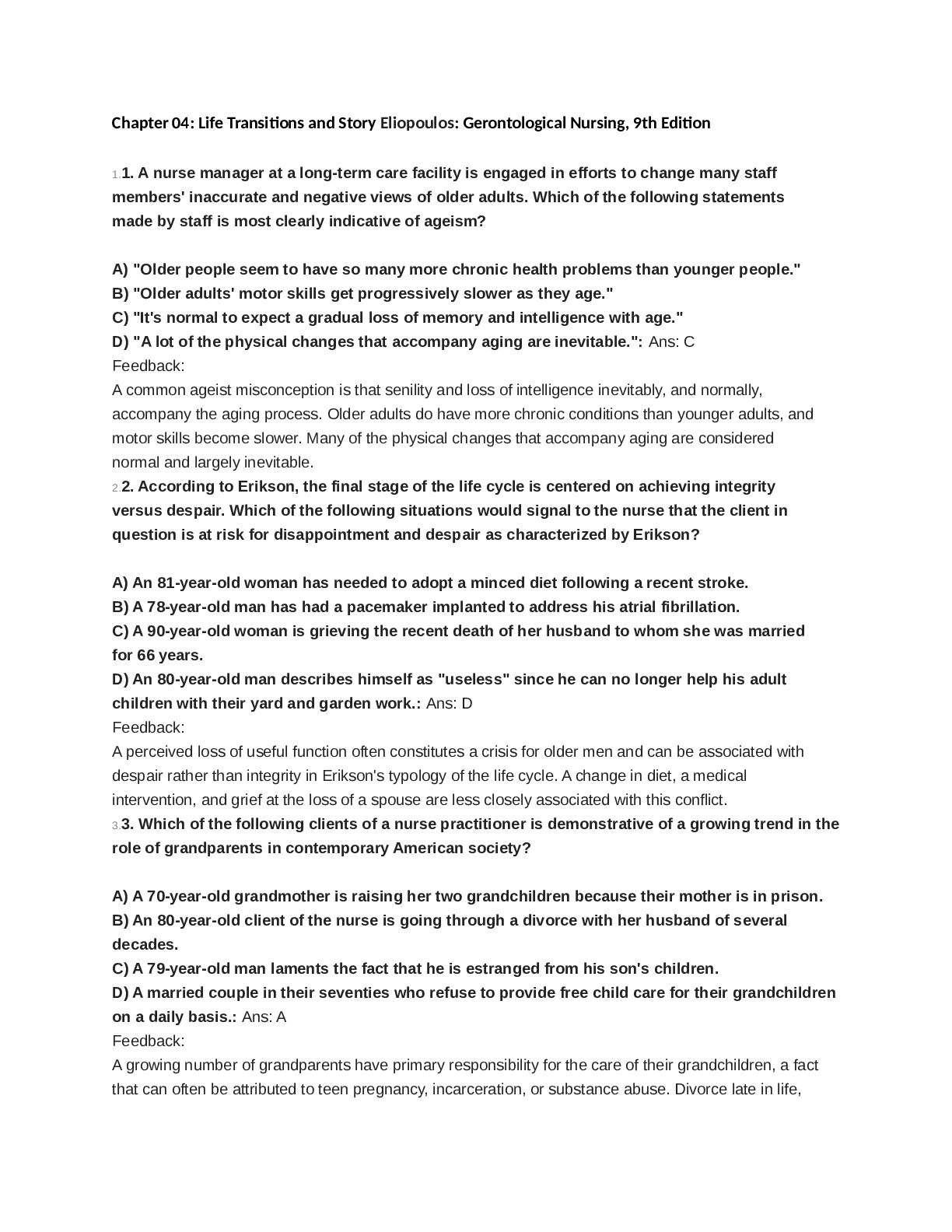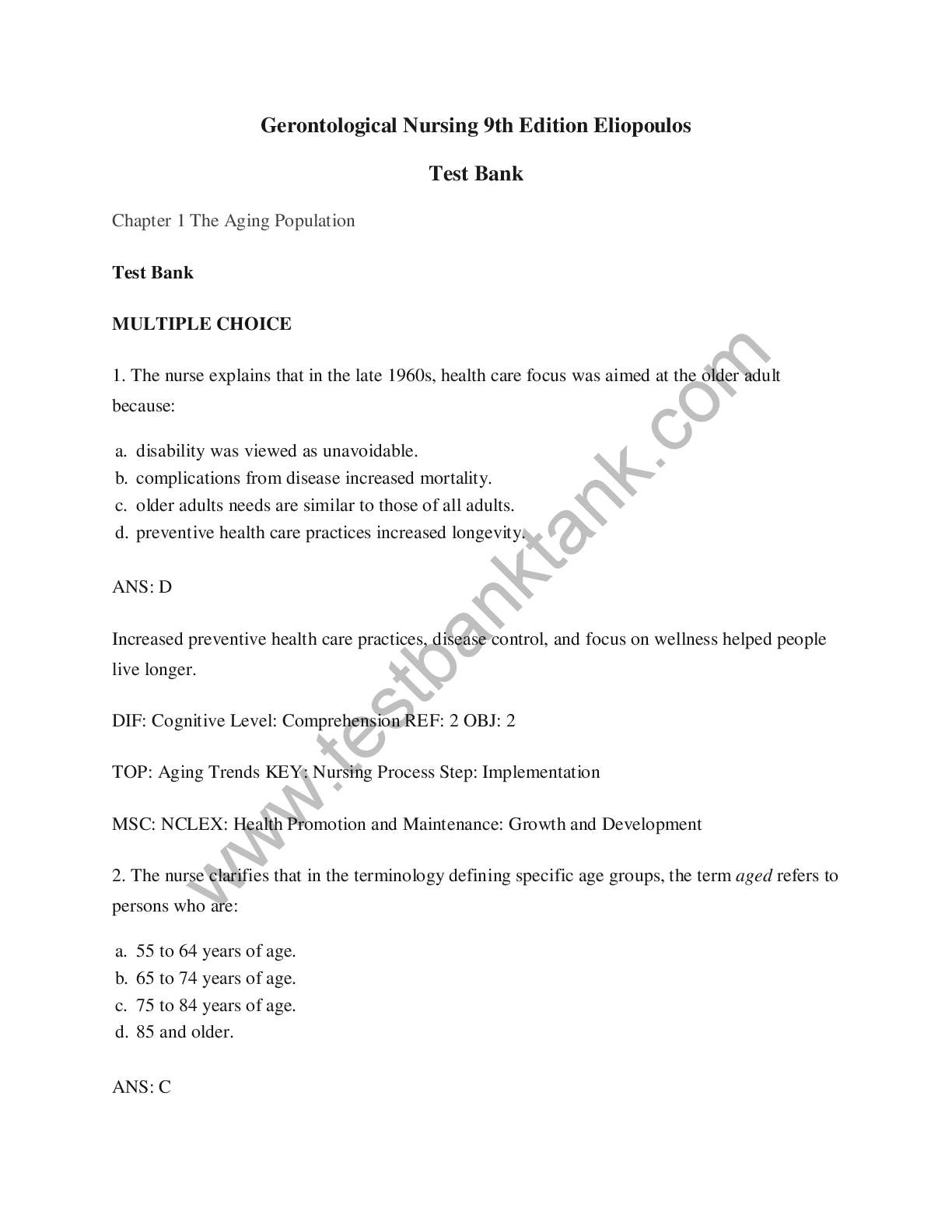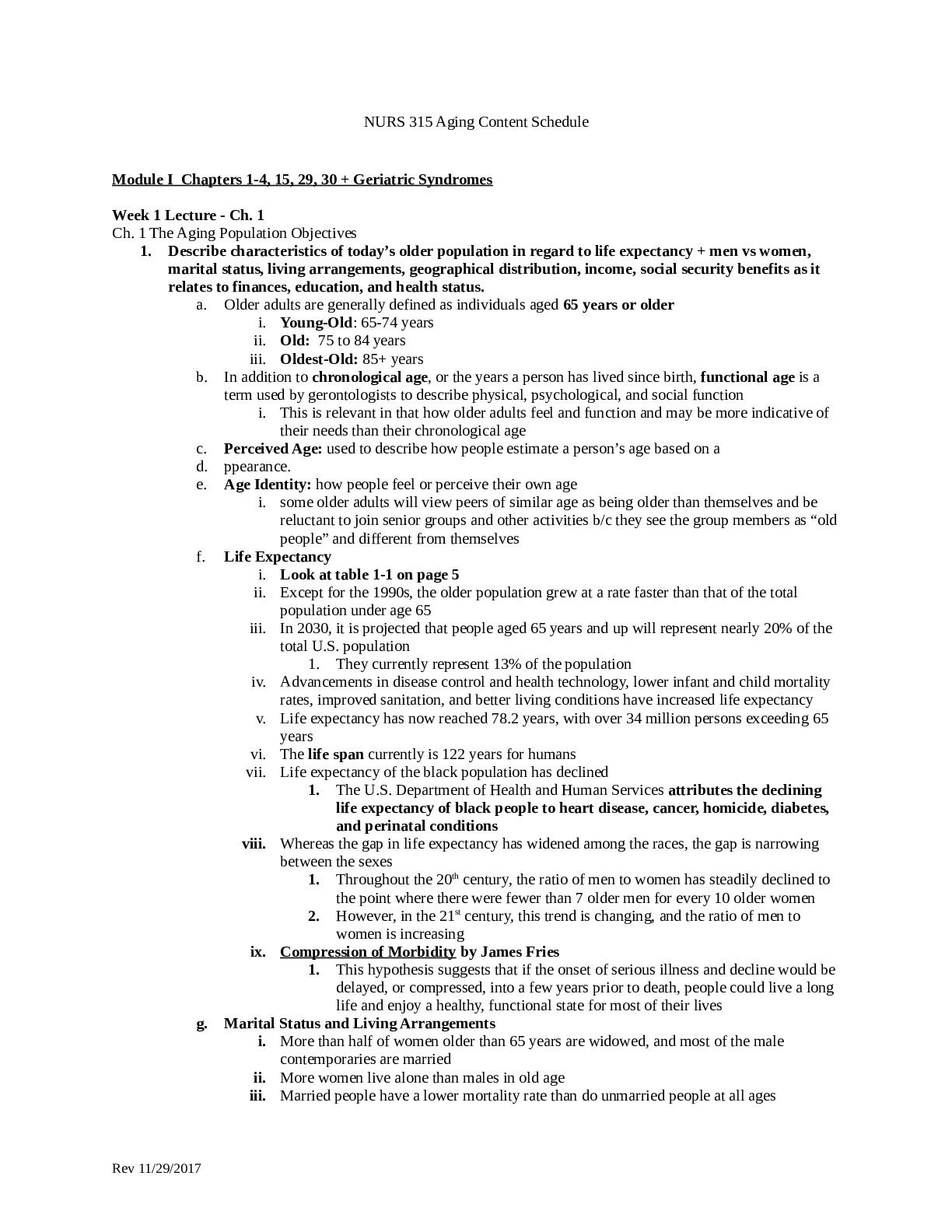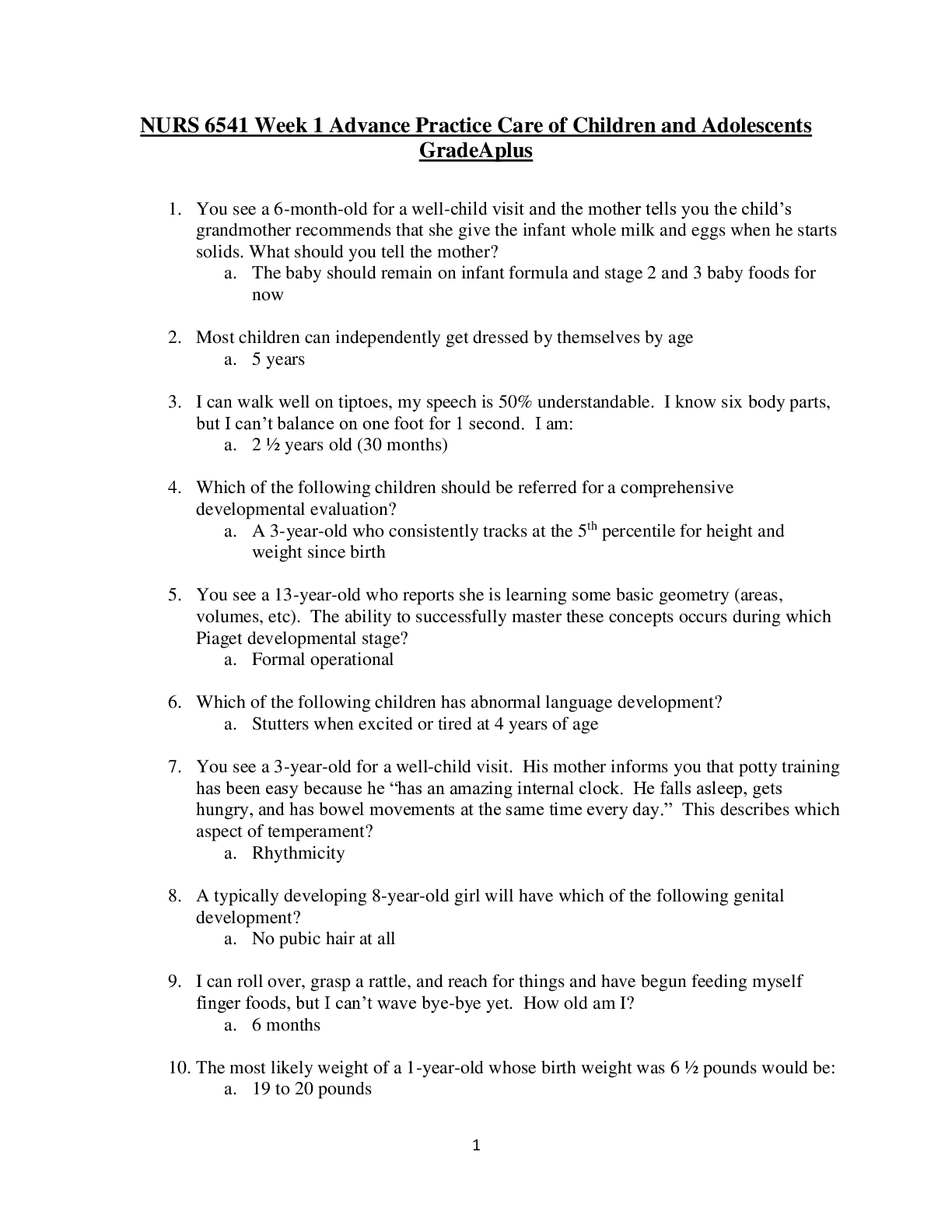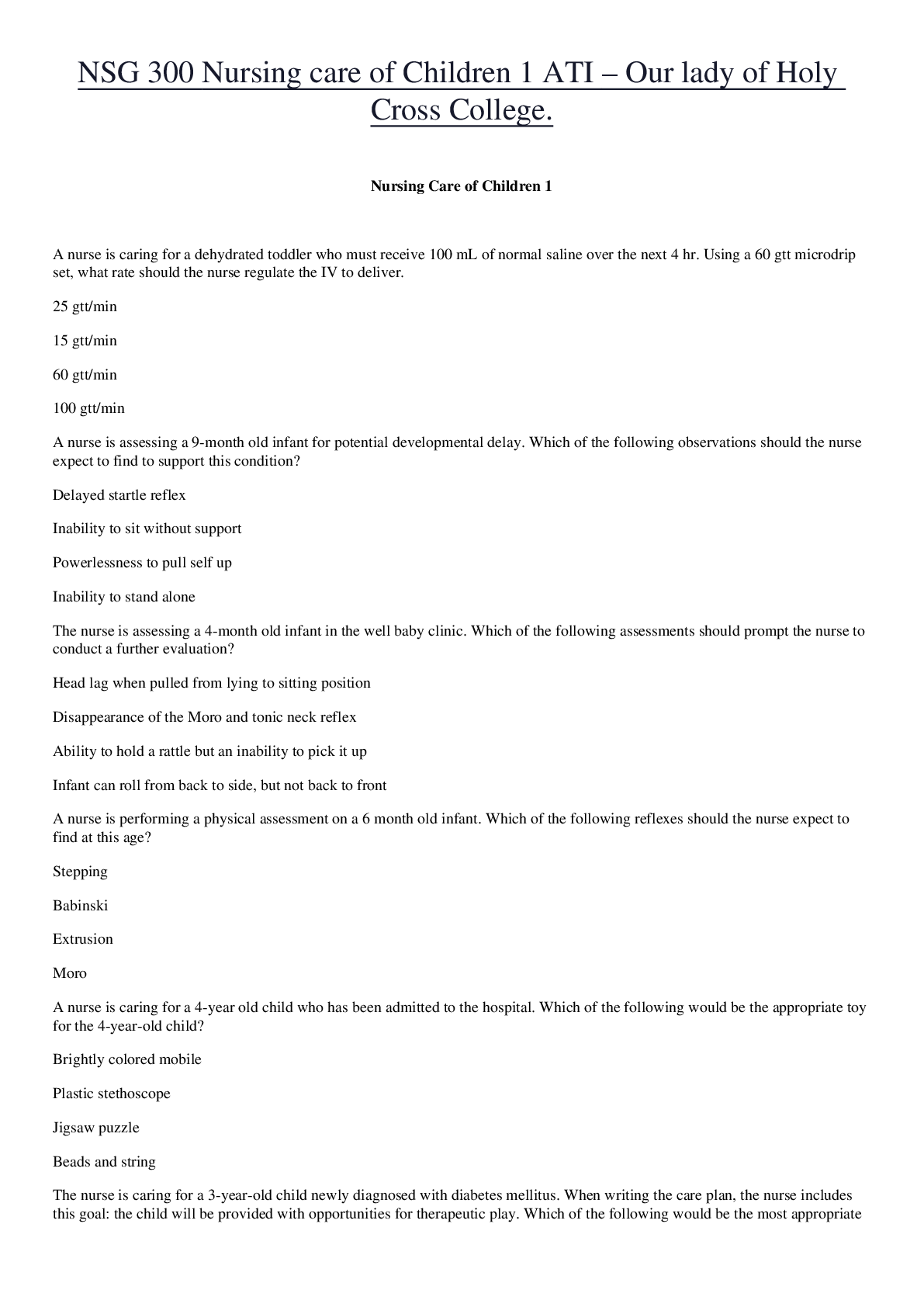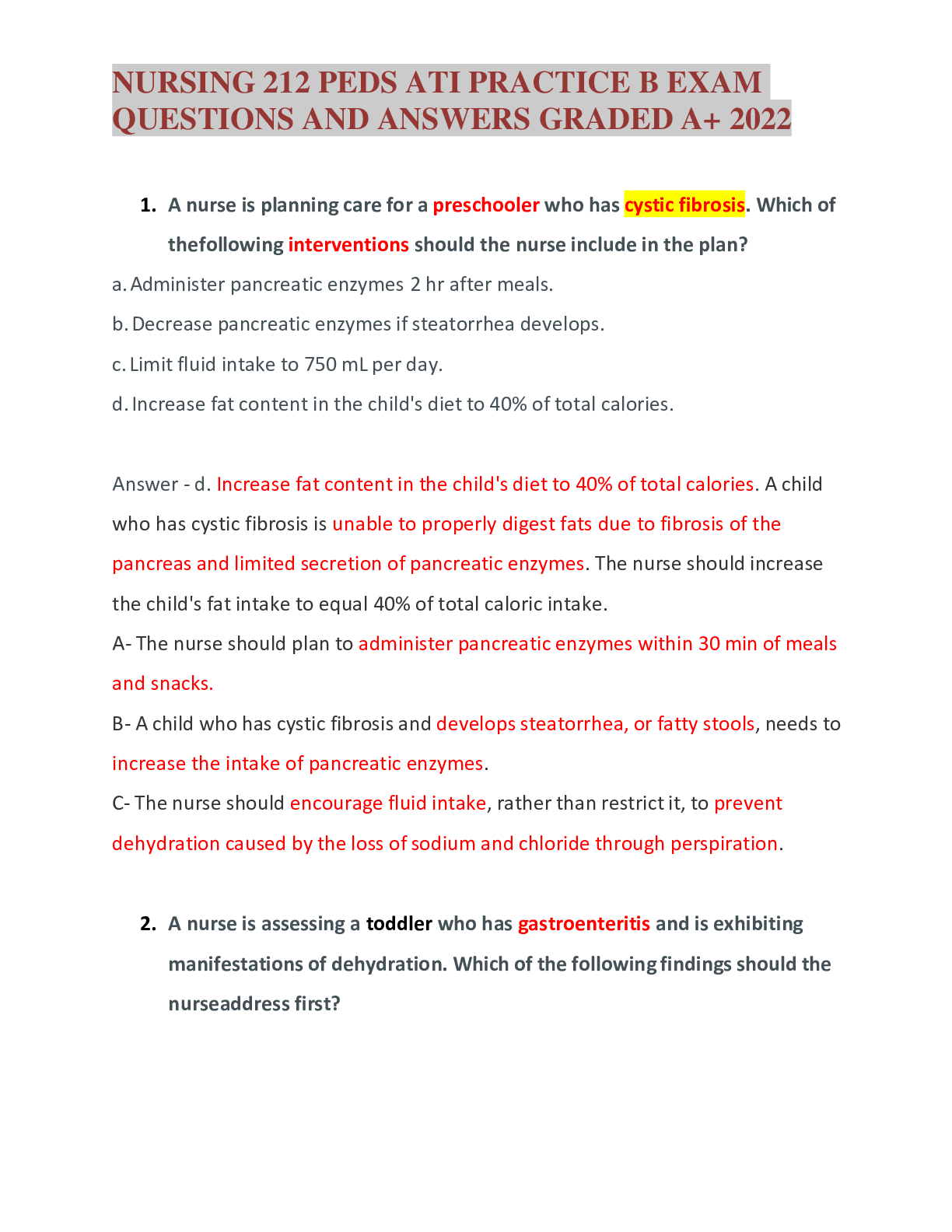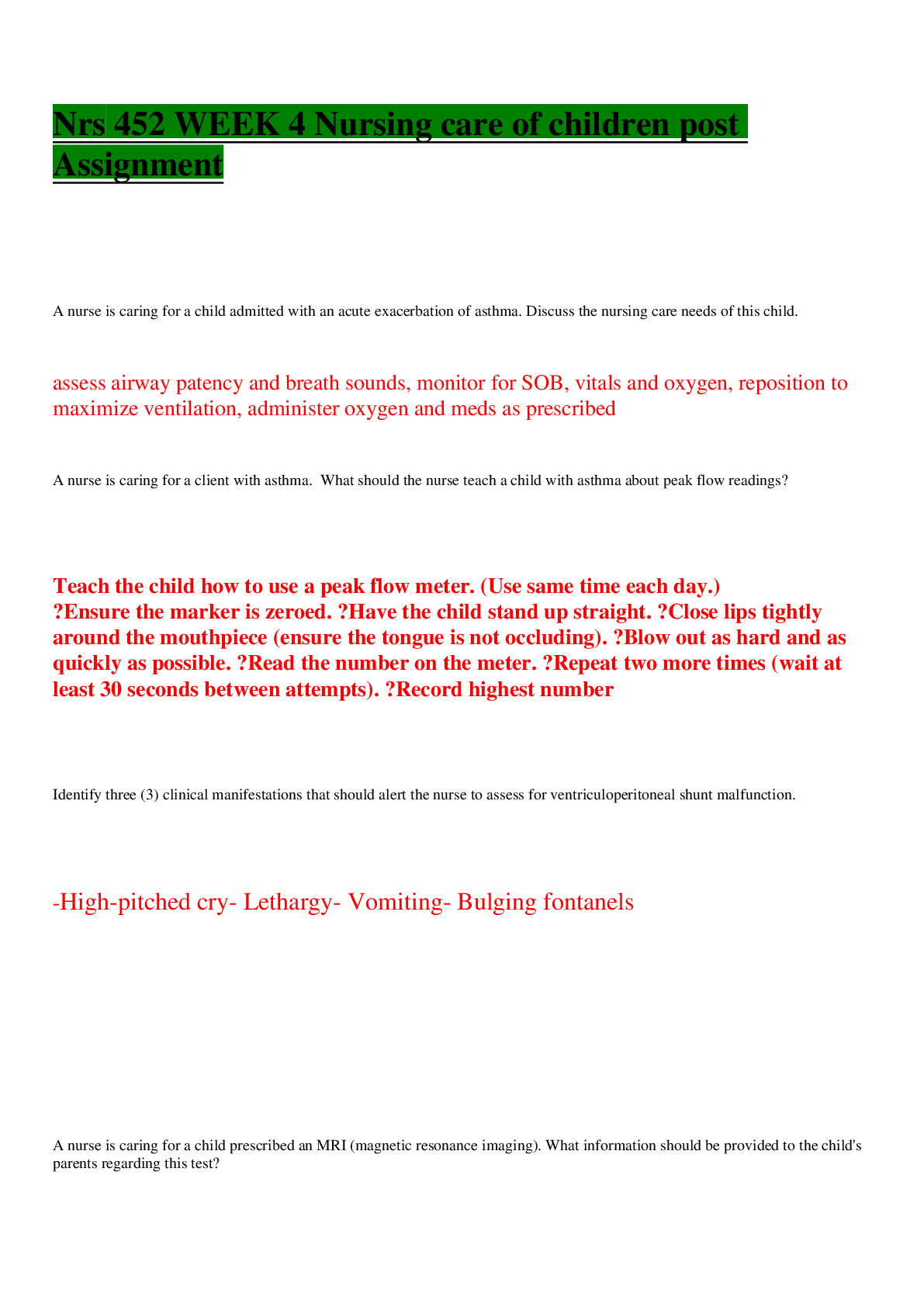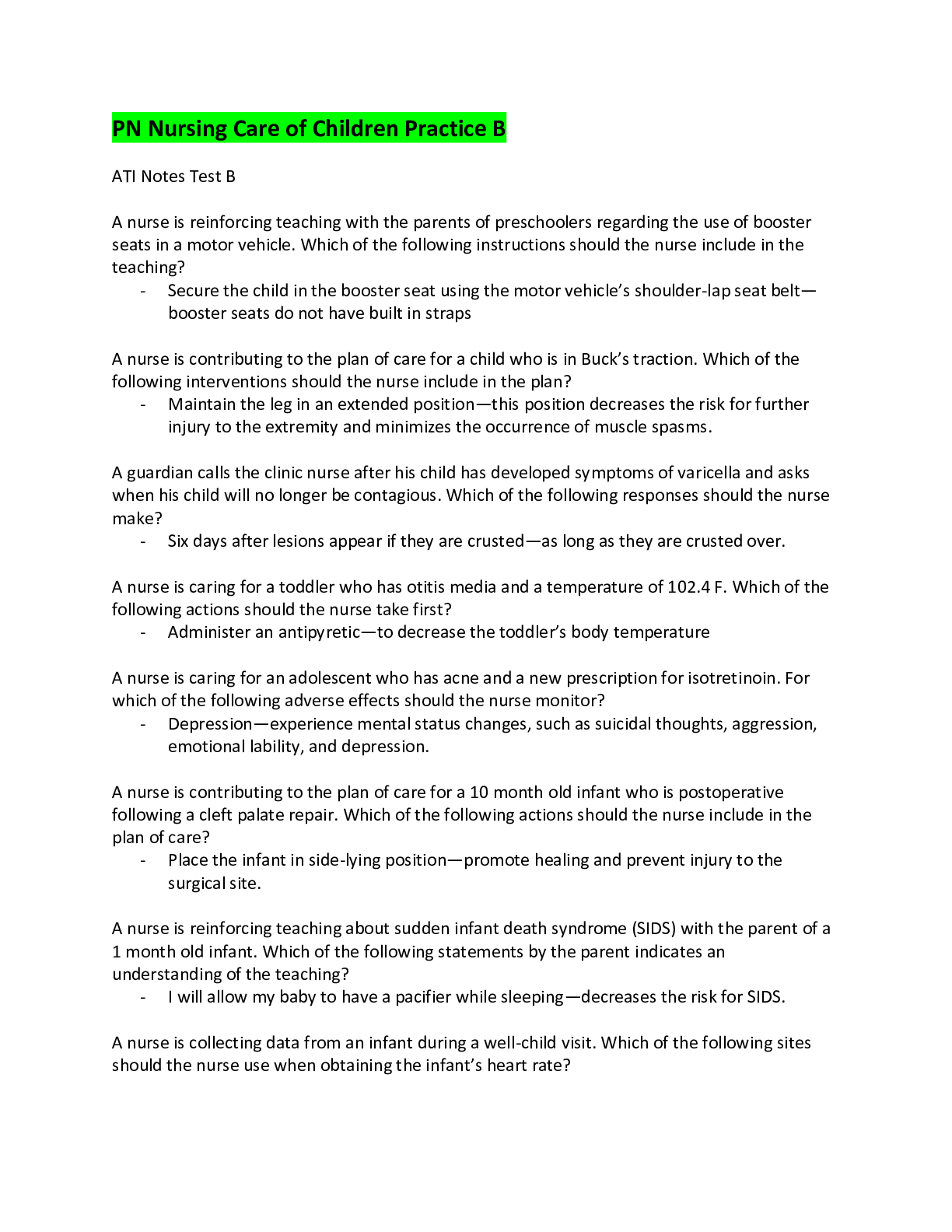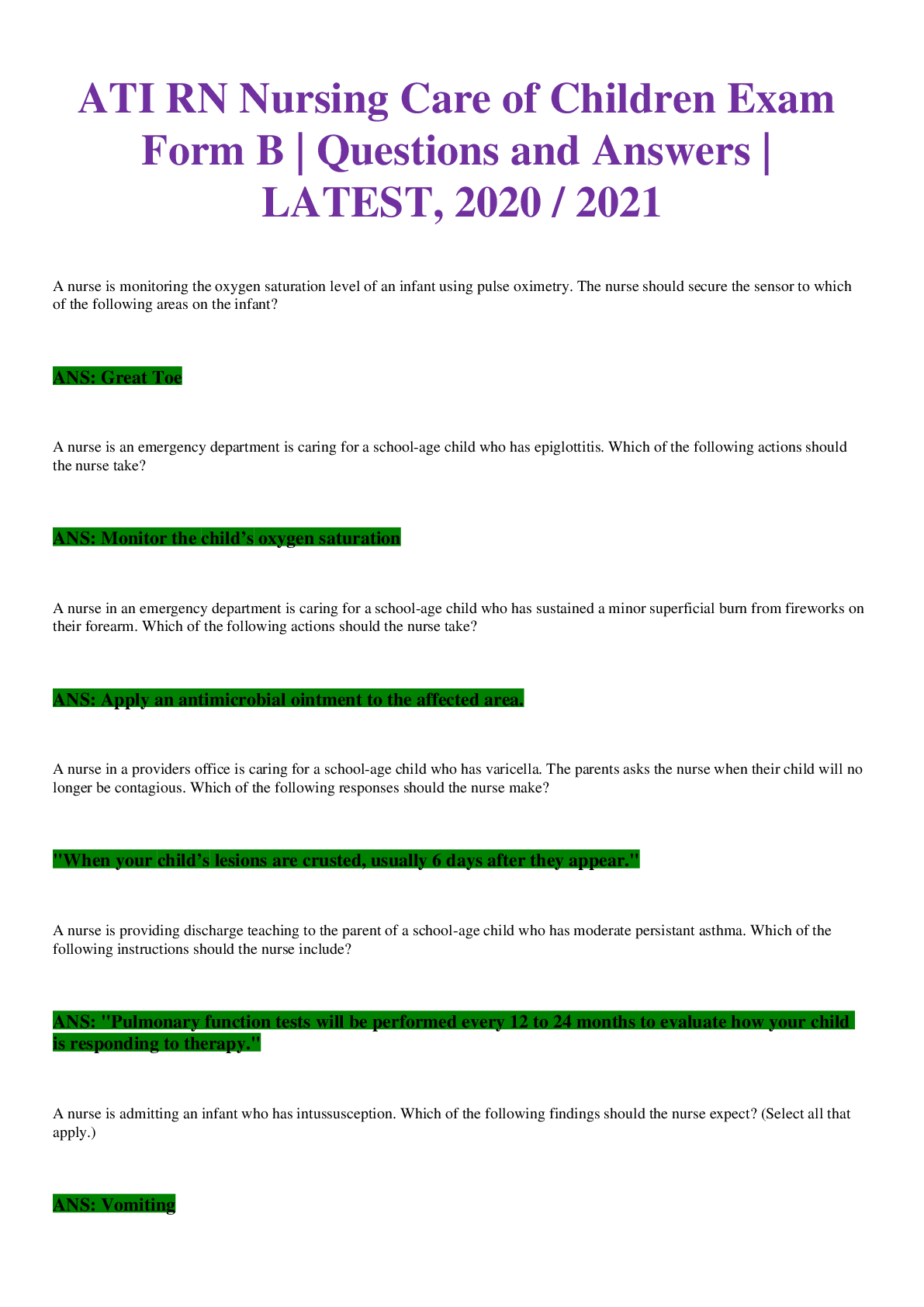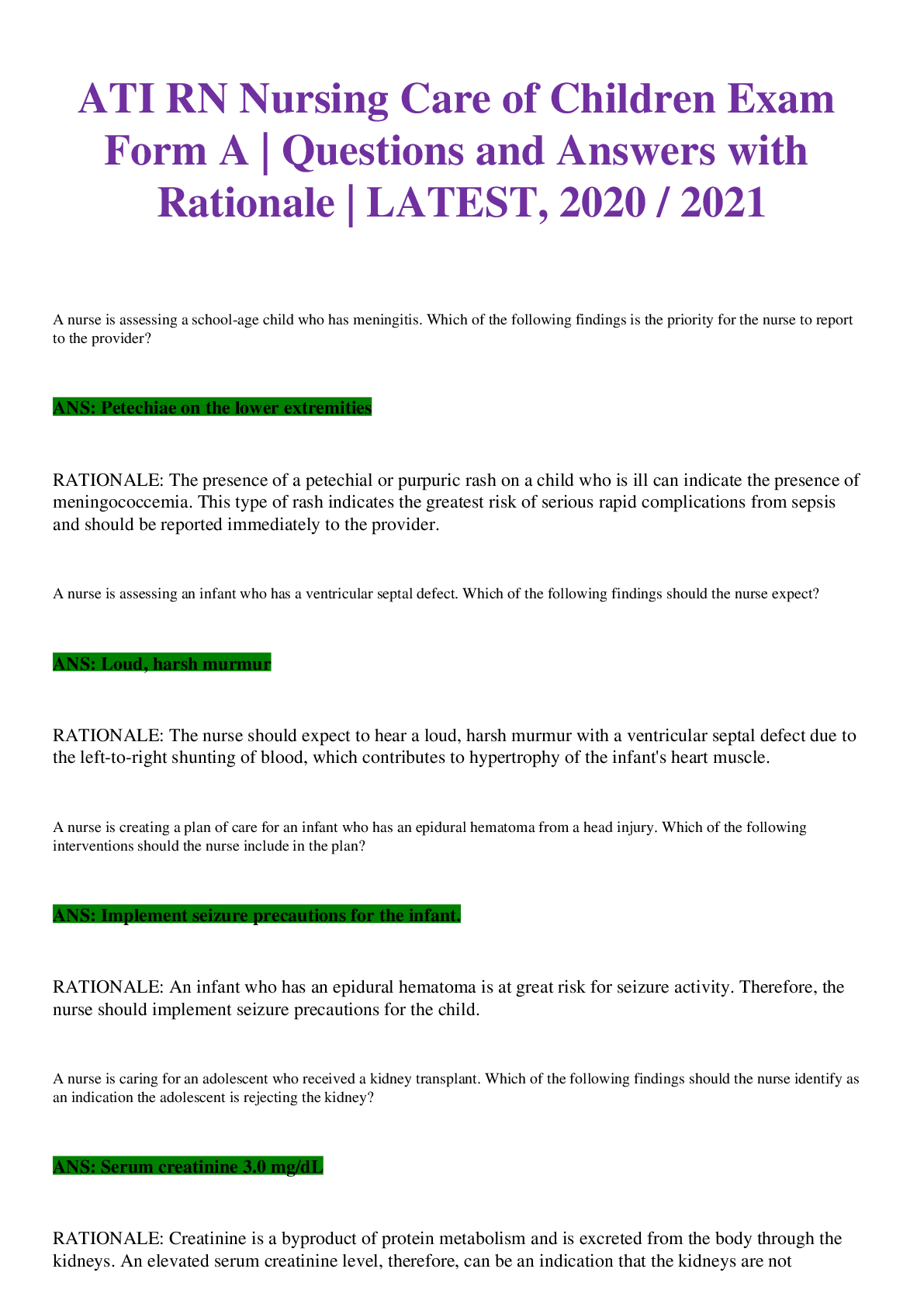Assessment- Rationales RN VATI Nursing Care of Children 2016
Document Content and Description Below
Assessment- Rationales RN VATI Nursing Care of Children 2016 2. "Your child will be exposed to a moderate amount of radiation during the procedure 3. Nausea 4. Initiate contact precaut... ions. 5. Warm extremities 6. The infant falls to a sitting position while learning how to walk. 8. "Your child's skin will appear flushed 9."Your child will lose movement in his legs." 10."Your child's blood pressure will start to increase." 11. Restrict the child's potassium intake 12. "I will cook foods that are low in fat and carbohydrates." 13. Administer factor VIII is correct 14. "My child should have 4 ounces of protein per day 15. BUN 32 mg/dL The nurse should identify this finding as above the expected reference range of 5 to 18 mg/dL for a child. A child who has glomerulonephritis will have an elevated BUN because of the impaired glomerular filtration rate, which results in retention of urea in the blood. Negative urine protein 17. Albumin Flat anterior fontanel The nurse should identify a flat anterior fontanel as an expected finding in an infant who has mild to moderate dehydration. An infant who has severe dehydration will exhibit a sunken anterior fontanel. Dry, hot skin The nurse should observe that an infant who is severely dehydrated has skin that is cool to the touch and mottled in appearance with the presence of tenting. Loss of 5% of weight The nurse should identify a loss of 5% of weight as a manifestation of mild dehydration. An infant experiencing a 6% to 9% weight loss has moderate dehydration, while a loss of 10% or more indicates severe dehydration. Absence of tears when crying MY ANSWER The nurse should identify the absence of tears when crying as a manifestation of severe dehydration. Other manifestations of severe dehydration include sunken eyeballs, parched mucous membranes, oliguria, sunken fontanels, and hyperpnea. 19. "Your child needs mechanical ventilation." The nurse should not tell the parent the child needs mechanical ventilation, as the child is awake and alert. A child who is not breathing on her own or is experiencing respiratory distress requires mechanical ventilation. "We need to observe your child for cerebral swelling." MY ANSWER The nurse should inform the parents that the child needs observation because she is still at risk for a complication from the submersion injury. Complications can include respiratory compromise and cerebral edema during the first 24 hr after the submersion. 20. "I will ensure that my child takes a 1 hour nap each day." A child who has JIA should be discouraged from sleeping during the day because it can cause joint stiffness and interfere with nighttime sleep. The child should instead rest daily with activities such as reading, watching television, and listening to music. "I will give my child prednisone as needed for pain." Prednisone is a glucocorticoid that acts as an anti-inflammatory agent and is given on a scheduled basis during exacerbations. "I will apply cool compresses to my child's painful joints during exacerbations." MY ANSWER The parent should apply moist heat, rather than cool compresses, to relieve pain and stiffness in affected joints. Having the child soak in a bathtub of warm water is an effective strategy for relieving pain and stiffness in multiple joints. "I will have my child wear splints during the night." The parent should have the child wear splints during the night to prevent joint deformities and reduce and minimize pain from inactivity 22. Initiate chelation therapy. The nurse should not initiate chelation therapy for a child who has ingested kerosene. Chelation therapy removes iron from circulating blood and is not useful for the treatment of hydrocarbon ingestion. Prepare for intubation with a cuffed endotracheal tube. The nurse should anticipate that the child will require intubation with a cuffed endotracheal tube because of the high risk of aspiration. This child is at risk for aspiration because she is lethargic, grunting, and gagging. Inject deferoxamine subcutaneously. Deferoxamine is an antidote used in the treatment of iron toxicity. It is not used in the treatment of hydrocarbon ingestion. Administer activated charcoal. MY ANSWER The nurse should administer activated charcoal to treat a child who has ingested excess aspirin. Add supplemental calcium to the child's diet. The nurse should not instruct the parents to increase the child's calcium intake. Immobilization increases the risk for hypercalcemia, leading to renal stones, muscle fatigue, and diminished reflexes. Decrease dietary fiber intake. The nurse should not instruct the parents to decrease the child's intake of fiber. Immobilization increases the risk for constipation and fecal impaction; therefore, the nurse should instruct the parents to increase the child's fiber intake. Encourage small, frequent meals high in protein. MY ANSWER The nurse should instruct the parents to provide small, frequent meals that are high in protein while their child is healing from surgery. Immobilization causes a decrease in appetite; therefore, small, frequent meals will be more readily tolerated. Adequate protein intake is needed for energy and tissue healing. Encourage foods that are low in calories. The nurse should not instruct the parents to provide foods that are low in calories. Immobilization decreases the metabolic rate and appetite. However, adequate healing requires calories to prevent undernutrition, nutrient deficiencies, and a negative nitrogen balance. The nurse should instruct the parents to provide nutrient-dense foods that are high in protein. 25. lement seizure precautions. The nurse should identify this potassium level as below the expected reference range of 4.1 to 5.3 mEq/L for infants. The nurse should monitor for cardiac abnormalities for an infant who has a potassium level outside the expected reference range. Offer the infant 15 mL of formula. The nurse should insert an NG tube to maintain gastric decompression prior to surgical correction of the stenosis. The nurse should keep the infant NPO. Check the infant's serum creatinine. The nurse should check the infant's serum creatinine and BUN levels prior to and during the administration of IV potassium to ensure renal function is adequate and avoid the development of hyperkalemia should renal failure occur. The nurse should also closely monitor intake and output to ensure adequate urinary output prior to and during the administration of IV potassium. Administer sodium polystyrene. MY ANSWER The nurse should identify this potassium level as below the expected reference range of 4.1 to 5.3 mEq/L for infants. Sodium polystyrene stimulates the body to excrete potassium through the large intestine and would worsen the infant's condition. "My child will be awake for this procedure." The child requires sedation for an endoscopy and bronchoscopy to prevent complications from this procedure; therefore, the child will not be awake during the procedure. "I can take my child home as soon as the procedure is over." The nurse will observe the child for complications, such as laryngeal edema, after the procedure. The child can go home when his vital signs are stable and he has a gag/cough reflex, which usually returns within a few hours. "The provider will remove the object during this procedure." MY ANSWER The provider is able to make a definitive diagnosis of objects in the larynx and trachea during a bronchoscopy and can subsequently remove the foreign body. "After this procedure, I have to wait 48 hours before I can give my child solid foods." Once the gag/cough reflex returns, the child can consume fluids and solid foods. This usually occurs within a few hours following the procedure. "Your child can eat and drink up to 2 hours prior to the test." In the event that bleeding or accidental perforation of an abdominal organ occurs, the child will need to be taken to surgery. The NPO status will decrease the risk of aspiration if surgery is necessary. "Your child will need to be on bed rest for 6 hours following the test." The nurse should instruct the parents that the child will need to be on bed rest for 24 hr following the test. The activity restriction is necessary to prevent bleeding following the procedure. "Your child will have a pressure dressing on the biopsy site following the test." MY ANSWER The nurse should instruct the parents that the child will have a pressure dressing on the site of the biopsy following the test to minimize bleeding. The nurse might also use a sandbag to maintain pressure to the puncture site. "Your child will receive contrast dye via an IV during the test." The nurse should instruct the parents that the child may receive oral pre-procedure medication for sedation for a renal biopsy; however, contrast dye is not used for this diagnostic test. 28. Anemia is incorrect. Tetralogy of Fallot is four defects that alter hemodynamics to widely varying degrees. Shunting can be in either direction depending on the degree of the defects and the differences between the pulmonary and the systemic vascular resistance. The chronic hypoxemia stimulates erythropoiesis, resulting in polycythemia, which is an increased number of RBCs. Stridor is incorrect. Stridor, a noisy, high-pitched respiration, is not a clinical manifestation of Tetralogy of Fallot. Bounding peripheral pulses is incorrect. Bounding peripheral pulses are not a clinical manifestation of Tetralogy of Fallot. A heart murmur is correct. Infants who have Tetralogy of Fallot exhibit a systolic murmur that is moderate in intensity. Cyanotic spells is correct. Infants who have Tetralogy of Fallot experience anoxic spells when the infant's oxygen requirements exceed the oxygen available in the blood supply, such as when the infant is crying or following a feeding. 30. "I will breathe in through the mouthpiece, hold my breath for 5 seconds, and then exhale." Breathing in through the mouthpiece and holding the breath for 5 seconds is an incorrect method of using the PEFM. The correct method of using the PEFM is to forcefully exhale for 1 second as quickly as possible to measure the amount of air exhaled. "If I get a reading in the green zone, I will tell my parents right away so they can call the doctor." Values in the green zone represent 80% to 100% of the child's personal best. This indicates that asthma is under good control and does not warrant calling the provider. "I will slowly exhale through the mouthpiece over a 10-second interval." MY ANSWER Slowly exhaling through the mouthpiece over a 10-second interval is an incorrect method of using the PEFM. The correct method of using the PEFM is to forcefully exhale for 1 second as quickly as possible to measure the amount of air exhaled. "I will record the highest reading of the three attempts." The child should forcefully exhale for 1 second as quickly as possible to measure the amount of air exhaled and repeat this process three times. The child should wait 30 seconds between attempts and record the highest of the three readings. 31. Administer the medication on an empty stomach. MY ANSWER The nurse should instruct the parents to administer the medication with meals or just before eating to prevent gastrointestinal upset. Encourage the child to brush his teeth after each meal. The nurse should recommend consistent dental hygiene to the parents of a child who has a prescription for phenytoin. This medication can cause gingival hyperplasia, and good oral hygiene reduces the risk of this occurring. Crush the child's medication to mix with applesauce. The nurse should instruct the parents to administer the extended-release capsule whole to ensure proper absorption and therapeutic plasma drug levels. Observe the child for diarrhea. The nurse should instruct the parents to monitor the child for constipation as an adverse effect of phenytoin. 33. Capillary refill greater than 4 seconds MY ANSWER The nurse should identify that a capillary refill time greater than 4 seconds indicates severe dehydration. An infant experiencing moderate dehydration will exhibit a capillary refill time of 2 to 4 seconds. Bradycardia The nurse should identify that bradycardia is not a manifestation of dehydration. An infant experiencing dehydration will exhibit a heart rate that is either within or above the expected range, depending upon the severity of fluid loss. Tachypnea The nurse should identify that tachypnea is a manifestation of moderate dehydration. As dehydration worsens, breathing becomes hyperpneic. Lethargy The nurse should identify that an infant who is lethargic has severe dehydration. An infant experiencing moderate dehydration will exhibit increased irritability. Face, Legs, Activity, Cry, Consolability (FLACC) scale MY ANSWER The nurse should use the FLACC scale to assess the toddler's pain level. The FLACC scale is used for infants and children from 2 months to 7 years. Color Tool scale The nurse should not use the Color Tool scale to assess pain in a toddler. The Color Tool scale is used for children ages 4 years old and older that are able to identify colors. FACES scale The nurse should not use the FACES pain rating scale to assess pain in a toddler. The FACES scale is used for children ages 3 years old and older and requires the child to identify pain by pointing to a face that represents the level of pain the child is experiencing. Visual Analog Scale (VAS) The nurse should not use the VAS pain scale to assess pain in a toddler. The VAS scale is used for children older than 4.5 years old and requires the child to make a written mark on a pain scale that represents the level of pain the child is experiencing. Vomiting is correct. The clinical manifestations of a brain tumor vary with the size and location of the tumor. Vomiting unrelated to feeding is a common finding. It tends to become progressively more projectile and is most severe in the morning. It can be accompanied by nausea and is a result of increased intracranial pressure. Easy bruising is incorrect. Anticoagulation is not associated with brain tumors. It is more likely to be seen with hematologic malignant disease (leukemia). Clumsiness is correct. Clumsiness, lack of coordination, and loss of balance are common manifestations of brain tumors. Manifestations result from pressure and interference with circulation within the brain. Irritability is correct. Irritability is a common behavioral manifestation of brain tumors. Other manifestations include anorexia, fatigue, lethargy, and bizarre behavior such as staring. Persistent headaches is correct. Headache is probably the most common symptom of brain tumors. Headaches result from pressure on pain-sensitive areas, such as large blood vessels and cranial nerves. Headaches tend to be worse in the morning and subside as the day progresses. The infant cannot turn pages in a book. The nurse should not expect an infant to turn pages in a book until the age of 12 months. The infant cannot build a tower of three cubes. The nurse should not expect an infant to build a tower of three cubes until the age of 18 months. The infant cannot sit steadily without support. MY ANSWER An infant who is 8 months old should be able to sit steadily without support; therefore, the nurse should report this finding to the provider because it might indicate developmental delay for a 10-month-old infant. The infant cannot imitate animal sounds. The nurse should not expect an infant to imitate animal sounds until the age of 12 months. 40. Apply a transparent dressing to the blood sample site. The nurse should hold pressure or place a pressure dressing on the venipuncture site after obtaining the blood sample. The removal of a transparent dressing can cause increased trauma to the child who has hemophilia. Apply a cold compress to the site prior to obtaining the sample. MY ANSWER The nurse should not apply a cold compress to the extremity prior to obtaining the blood sample, because this will cause vasoconstriction, making it more difficult to obtain the blood sample. Perform an Allen test prior to obtaining the blood sample. An Allen test is a procedure used to assess arterial circulation prior to obtaining arterial blood samples. An aPTT requires venous blood sampling. Obtain the sample using venipuncture. The nurse should obtain the blood sample by venipuncture because this method allows for less bleeding than a finger puncture. 41. Administer ibuprofen for pain. The nurse should not instruct the parents to administer ibuprofen to the toddler, because nonsteroidal anti-inflammatory drugs increase the risk of bleeding. The nurse should instruct the parents to administer acetaminophen if the child experiences pain. Place knee pads on the child. As toddlers grow and explore, it is important that parents of a child who has hemophilia take measures to make the environment safe. This can include measures such as installing carpeting over ceramic tiled floors or placing knee and elbow pads on the child to protect the child's joints from injury and bleeding. Limit the child's physical activity. MY ANSWER The nurse should instruct the parents to allow the child to participate in age-appropriate activities to foster motor development. The parents should provide close supervision during playtime to decrease the likelihood of accidental injury. Use a firm-bristled toothbrush for dental care. The nurse should instruct the parents of the child to use a soft-bristled toothbrush when providing oral care to the toddler to avoid bleeding and minimize oral trauma. Soft, foam toothettes that are disposed of after use can also be used. 42. Accompany verbal instructions with visual references. The nurse should instruct the teachers to use visual references along with verbal instructions for children who have ADHD. Using both verbal and written instruction provides clear communication of expectations for the children. Vary the classroom routine to keep the children interested. MY ANSWER The nurse should not instruct the teachers to vary their classroom routine to maintain the interest of children who have ADHD. Children who have ADHD require a consistent environment that is predictable to assist with focus and the ability to complete expected tasks. Limit presentation of subjects of interest to the children to the afternoons. The nurse should encourage the teachers to alternate topics of high interest to the children with topics of less interest. This will help retain the attention of the children. Increase classroom assignments to stimulate learning. The nurse should not instruct the teachers to increase classroom assignments for children who have ADHD. Teachers might need to decrease classroom assignments to allow the children time to complete the work. 43. Expiratory wheeze An expiratory wheeze is an expected finding for a child who is experiencing an asthma attack and should be reported to the provider to allow for effective treatment; however, there is another finding that is the nurse's priority to report to the provider. Heart rate 100/min A heart rate of 100/min is an expected finding for a child who is experiencing an asthma attack and should be reported to the provider to allow for effective treatment; however, there is another finding that is the nurse's priority to report to the provider. Profuse sweating Profuse sweating indicates that this child is at greatest risk for severe respiratory distress and requires immediate intervention; therefore, this is the nurse's priority finding to report to the provider. Other manifestations include refusal to lie down and sudden agitation or drowsiness. The nurse should report any of these manifestations to the provider and remain with the child in case intubation becomes necessary. Oxygen saturation 91% MY ANSWER An oxygen saturation of 91% is an expected finding for a child who is experiencing an asthma attack and should be reported to the provider to allow for effective treatment; however, there is another finding that is the nurse's priority to report to the provider. 44. The infant exhibits a fear of strangers. The nurse should expect a 6-month-old infant to exhibit a fear of strangers when the ability to recognize his parents develops. The infant understands the word "no." The nurse should expect a 9-month-old infant to understand the word "no" and to respond to basic commands from the parents. The infant has an absent grasp reflex. The nurse should expect a 4-month-old infant to have an absent grasp reflex because this primitive reflex disappears at 3 months of age. The nurse should expect the infant to grasp objects with both hands at this stage of development. The infant rolls from his back to his abdomen. MY ANSWER The nurse should expect a 6-month-old infant to reposition himself to a prone position from a supine one. At 4 months of age, the infant should be able to roll from his back to his side. 45. Shallow respirations MY ANSWER The nurse should not expect the toddler to have shallow respirations, as this is a manifestation of hypoglycemia. A toddler who is experiencing hyperglycemia exhibits deep, rapid (Kussmaul) respirations. Moist mucous membranes The nurse should not expect the toddler to have moist mucous membranes. A toddler who is experiencing hyperglycemia exhibits dry mucous membranes. Skin pallor The nurse should not expect the toddler to have skin pallor, as this is a manifestation of hypoglycemia. A toddler who is experiencing hyperglycemia exhibits flushed skin and might have signs of dehydration. Lethargic mood The nurse should expect the toddler to be lethargic. A toddler who is experiencing hypoglycemia will be irritable and have a labile mood. 46. Applying heat to the affected areas MY ANSWER The nurse should apply heat to the affected areas to increase circulation and decrease pain; however, another action is the priority. Administering prophylactic antibiotics The nurse should administer prophylactic antibiotics to prevent bacterial infection because the adolescent's body has a decreased ability to fight infection; however, another action is the priority. Infusing blood products The nurse should administer blood products to correct anemia and reduce blood viscosity; however, another action is the priority. Promoting rest The first action the nurse should take when using the airway, breathing, circulation approach to client care is to increase tissue oxygenation. An adolescent who has sickle cell anemia and is experiencing a vasoocclusive crisis has a higher requirement for cellular oxygenation; therefore, the nurse should reduce the client's metabolic demands for oxygen and limit cardiac oxygen consumption by encouraging rest. Elevate the child's residual limb for 48 hr. The nurse should plan to elevate the child's residual limb for the first 24 hr following surgery. Elevating the leg longer than 24 hr can cause hip contractures and lead to difficulties with future ambulation. Apply a loose-fitting bandage onto the child's residual limb. The nurse should plan to apply an elastic bandage in a figure-eight pattern to apply pressure to the residual limb. A pressure dressing controls edema, decreases the likelihood of hemorrhage, and assists in contouring the residual limb for future prosthetic placement. Perform active and isotonic range-of-motion exercises. MY ANSWER The nurse should plan to perform both active and isotonic range-of-motion exercises of the joints above the amputation site several times per day. This will maintain joint mobility, which is necessary for future ambulation. Clean the incision using half-strength hydrogen peroxide every 8 hr. The nurse should not plan to clean the incision with half-strength hydrogen peroxide, as this can irritate the tissue. The nurse should clean the incision with soap and water each day while assessing the limb for manifestations of infection or skin breakdown. Hot dogs MY ANSWER Acute glomerulonephritis is a renal disorder resulting in edema, hypertension, hematuria, and proteinuria. If required, dietary changes require limitation of foods that are high in sodium because of the edema and hypertension. The nurse should recommend the elimination of hot dogs from the child's diet, as processed meats are high in sodium. Canned mixed fruit The nurse should identify that canned mixed fruit is very low in sodium and is permissible for the child who has acute glomerulonephritis. Steamed green beans The nurse should identify that steamed green beans are very low in sodium and are permissible for the child who has acute glomerulonephritis. Beans are also an excellent source of complex carbohydrates, which are recommended for this client. Whole wheat macaroni The nurse should identify that whole wheat macaroni is very low in sodium and is permissible for the child who has acute glomerulonephritis. In addition, whole wheat macaroni is an excellent source of complex carbohydrates, which are recommended for this client. 50. Insert the tip of the thermometer 5 cm (2 in) into the rectum. The nurse should insert the tip of the thermometer no more than 2.5 cm (1 in) into the child's rectum to prevent injury. Place the child in prone position. The nurse should place the child in a side-lying, supine, or prone position to obtain a rectal temperature. Stabilize the thermometer at the distal end. The nurse should stabilize the thermometer close to the child's rectum to prevent injury. Direct the tip of the thermometer toward the spine during insertion. MY ANSWER The nurse should direct the tip of the probe toward the umbilicus during insertion because this is the direction of the rectum. Pointing the tip of the thermometer toward the spine can increase the risk of rectal perforation. 52. 6 months MY ANSWER The nurse should expect infants to begin adding consonants to simple syllables (da-da, wa-wa) and begin to imitate sounds at around 6 months of age. 12 months The nurse should expect an infant to begin speaking three to five words with meaning at around 12 months of age. 18 months The nurse should expect a toddler to speak ten or more words at around 18 months of age. The toddler should also form simple word combinations. 24 months The nurse should expect a toddler to speak approximately three-hundred words at around 24 months of age. The toddler should also use two- and three-word 53. "Your child should not receive the measles, mumps, and rubella vaccine." MY ANSWER The CD4 count is a measurement of lymphocytes, which plays a role in cellular immune function. Adequate immune function is indicated by a CD4 count of 600 to 1,500 cells/µL. At levels less than 200 cells/µL, the child is at increased risk for opportunistic infections. A child who has HIV and a CD4 level within the expected reference range should receive immunizations against common childhood illnesses, such as MMR and varicella. "Your child should receive the pneumococcal vaccine." Immunizations are an important factor in maintaining a child's health. A child who has HIV and a CD4 level within the expected reference range should receive the pneumococcal vaccine. "Household members should avoid receiving the varicella vaccine." It is not necessary for household members living with a child who has HIV and a CD4 level within the expected reference range to avoid receiving the varicella vaccine, because there is no evidence of immunosuppression. "Your child will need IV gamma globulin prophylaxis if exposed to pediculosis." IV gamma globulin prophylaxis is administered to children who are exposed to or develop recurrent bacterial infections. Pediculosis, or lice, is treated with medicated shampoo and manual removal of nits. A child who has HIV and a CD4 level within the expected reference range does not require an alternative treatment for pediculosis. Place a throw rug under the crib. MY ANSWER The nurse should instruct the parent to place a throw rug under the crib because the toddler can fall out of the crib. The nurse should also instruct the parent to move the toddler to a youth bed when he is able to climb out of the crib. Select a toy box with a heavy, hinged lid. The nurse should instruct the parent to select a toy box with a lid the toddler can easily open. A toy box with a heavy, hinged lid places the toddler at risk for injury or suffocation if entrapment occurs. Offer marshmallows as a snack food. The nurse should instruct the parent not to offer marshmallows as a snack food, because they are a choking hazard. If the toddler does not chew the marshmallow completely, it can occlude his airway. Set the water heater temperature to 54.4° C (130° F). The nurse should instruct the parent to set the temperature on the hot water heater at no more than 49° C (120° F) to prevent scalding of the toddler. A is correct. To document the appropriate area on the growth chart, obtain a chart designated for the infant's age and gender. Next, the nurse should find the marker for age at the bottom of the chart. Then, on the right side of the page, the nurse should determine the marker for weight in either kg or lb and plot them on the graph accordingly. If the points plotted are within the two bolded lines, representing the 5th and 95th percentiles, the child's development in terms of these parameters is appropriate. This is the correct documentation of the infant's weight. B is incorrect. To document the appropriate area on the growth chart, obtain a chart designated for the infant's age and gender. Next, the nurse should find the marker for age at the bottom of the chart. Then, on the right side of the page, the nurse should determine the markers for weight in either kg or lb and plot them on the graph accordingly. According to this point on the chart, the infant is 13 months old and weighs 11.3 kg (24.9 lb). C is incorrect. To document the appropriate area on the growth chart, obtain a chart designated for the infant's age and gender. Next, the nurse should find the marker for age at the bottom of the chart. Then, on the right side of the page, the nurse should determine the markers for weight in either kg or lb and plot them on the graph accordingly. According to this point on the chart, the infant is 11 months old and weighs 9.5 kg (20.9 lb). D is incorrect. To document the appropriate area on the growth chart, obtain a chart designated for the infant's age and gender. Next, the nurse should find the marker for age at the bottom of the chart. Then, on the right side of the page, the nurse should determine the markers for weight in either kg or lb and plot them on the graph accordingly. According to this point on the chart, the infant is 13 months old and weighs 10.2 kg (22.5 lb). 56. Chill the medication prior to administration. The nurse should instruct the parents that the otic solution should be at room temperature before instilling in the ear to minimize discomfort. Pull the pinna up and back during medication administration. MY ANSWER The nurse should instruct the parents to gently pull the pinna downward and straight back during administration of the medication to the infant. This positions the ear canal and eustachian tube to ensure correct placement of the medication. Hyperextend the infant's neck during medication administration. The nurse should not instruct the parents to hyperextend the infant's neck when administering ear drops, as this is the position used to administer nasal medications. The nurse should instruct the parents to turn the infant's head to the appropriate side while in the prone or supine position. After instilling the medication, the parents should keep the infant in a lateral position for a few minutes to ensure the medication reaches the target area. Massage the anterior area of the ear following administration. The nurse should instruct the parents to massage the anterior area of the ear, just in front of the tragus, following administration to facilitate instillation of the medication into the ear canal. This action assists the medication in reaching the target area. 58. Indomethacin The nurse should not plan to administer indomethacin to a child who has cerebral palsy and is experiencing muscle spasms. Indomethacin is an anti-inflammatory medication used in the treatment of gout. Baclofen The nurse should plan to administer baclofen to a child who has cerebral palsy and muscle spasms because it is a centrally acting skeletal muscle relaxant that will decrease muscle spasm and severe spasticity. Methotrexate The nurse should not plan to administer methotrexate to a child who has cerebral palsy and is experiencing muscle spasms. Methotrexate is an antineoplastic medication used to treat various cancers and rheumatoid arthritis. Carbamazepine MY ANSWER The nurse should not plan to administer carbamazepine to a child who has cerebral palsy and is experiencing muscle spasms. Carbamazepine is an anticonvulsant used to treat seizures. Maintain clean technique during the child's dressing changes. The nurse should perform dressing changes using sterile technique to prevent infection. Delayed wound healing can occur due to infection, which can also cause partial-thickness wounds to develop into full-thickness wounds. Provide low calorie snacks for the child several times each day. Burn injuries create a hypermetabolic state, requiring an increase of up to three times the normal calorie requirements. The nurse should provide high-calorie, high-protein snacks to promote healing and replace calories and proteins that are expended due to the child's increased metabolism. Apply continuous passive motion devices to lower the child's extremities during periods of rest. The nurse should apply splints to the child's lower extremities during periods of rest and sleep to minimize the development of flexion contractions. Administer pain medication to the child 30 min before physical therapy. MY ANSWER The nurse should administer pain medication to the child 30 to 45 min prior to painful procedures, such as physical therapy or dressing changes. Adequate pain control is needed so the child will actively participate and cooperate during physical therapy. 60. "I will give lansoprazole 30 minutes after her feeding." The mother should give lansoprazole to her infant 30 min before feeding. Administering lansoprazole, a proton pump inhibitor, 30 min prior to meals ensures the peak plasma concentration of the medication occurs during mealtimes. This medication reduces gastric hydrochloric acid secretion and can stimulate an increase in lower esophageal sphincter tone, which can prevent reflux of stomach contents into the esophagus. "I will lay my baby on her side after feedings." MY ANSWER The parent should not lay her infant down following a feeding, as this position will worsen gastroesophageal reflux. The parent should place the infant upright in an infant seat or raise the head of the bed 30° for 1 hr after feedings. "I will add rice cereal to my baby's feedings." The mother can add rice cereal to formula or expressed breast milk to thicken the feedings. Thickened feedings can decrease the number of vomiting episodes the infant experiences. "I will use a nipple that has a wide base to feed her." The parent should create a larger hole within the nipple to help the infant suck more easily. A wide-based nipple is used for feeding infants who have a cleft lip. [Show More]
Last updated: 1 year ago
Preview 1 out of 19 pages
Instant download
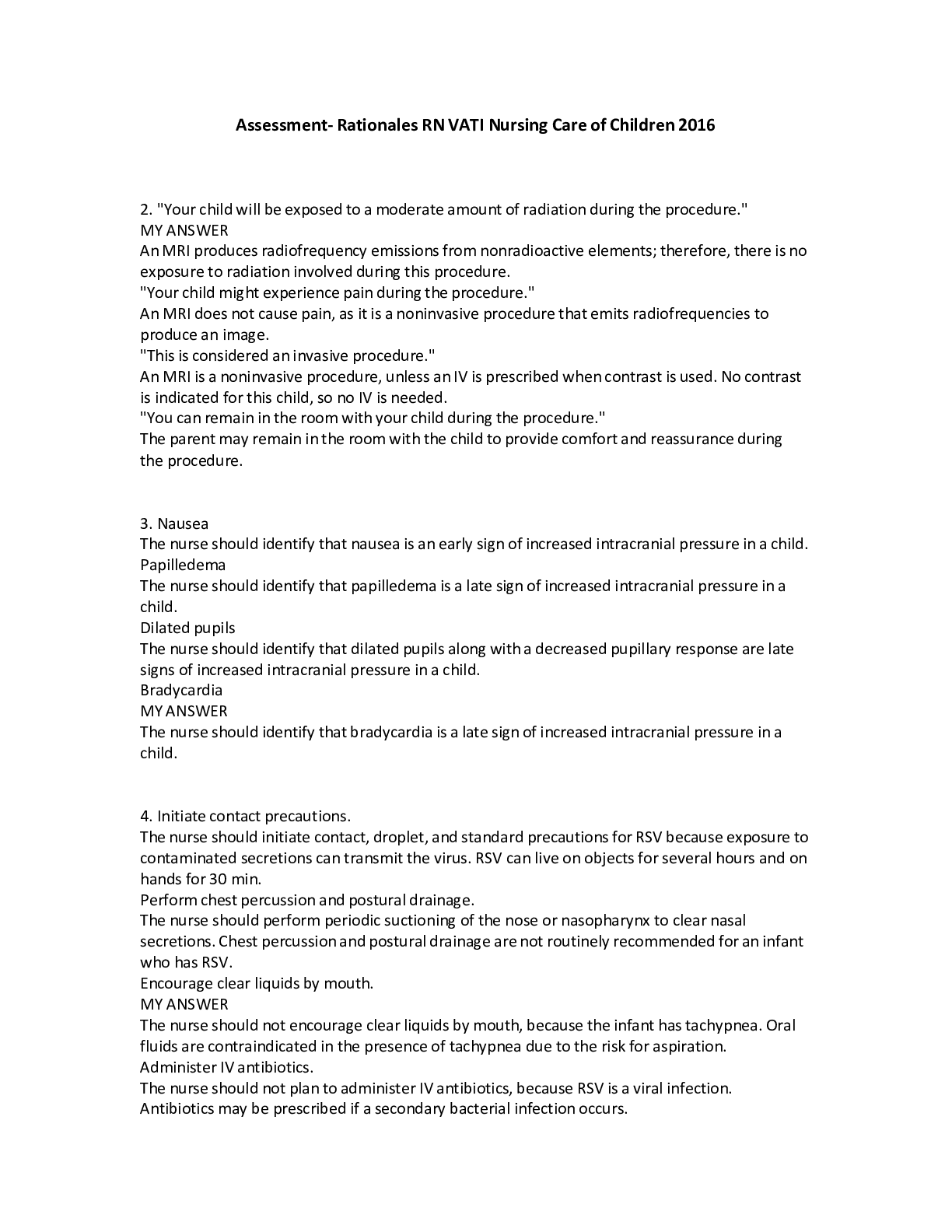
Buy this document to get the full access instantly
Instant Download Access after purchase
Add to cartInstant download
Reviews( 0 )
Document information
Connected school, study & course
About the document
Uploaded On
Aug 06, 2021
Number of pages
19
Written in
Additional information
This document has been written for:
Uploaded
Aug 06, 2021
Downloads
0
Views
52



